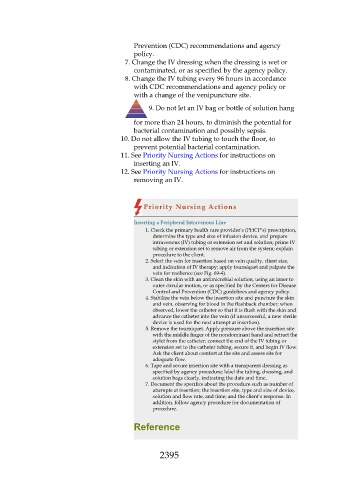Page 2395 - Saunders Comprehensive Review For NCLEX-RN
P. 2395
Prevention (CDC) recommendations and agency
policy.
7. Change the IV dressing when the dressing is wet or
contaminated, or as specified by the agency policy.
8. Change the IV tubing every 96 hours in accordance
with CDC recommendations and agency policy or
with a change of the venipuncture site.
9. Do not let an IV bag or bottle of solution hang
for more than 24 hours, to diminish the potential for
bacterial contamination and possibly sepsis.
10. Do not allow the IV tubing to touch the floor, to
prevent potential bacterial contamination.
11. See Priority Nursing Actions for instructions on
inserting an IV.
12. See Priority Nursing Actions for instructions on
removing an IV.
Priority Nursing Actions
Inserting a Peripheral Intravenous Line
1. Check the primary health care provider’s (PHCP’s) prescription,
determine the type and size of infusion device, and prepare
intravenous (IV) tubing or extension set and solution; prime IV
tubing or extension set to remove air from the system; explain
procedure to the client.
2. Select the vein for insertion based on vein quality, client size,
and indication of IV therapy; apply tourniquet and palpate the
vein for resilience (see Fig. 69-4).
3. Clean the skin with an antimicrobial solution, using an inner to
outer circular motion, or as specified by the Centers for Disease
Control and Prevention (CDC) guidelines and agency policy.
4. Stabilize the vein below the insertion site and puncture the skin
and vein, observing for blood in the flashback chamber; when
observed, lower the catheter so that it is flush with the skin and
advance the catheter into the vein (if unsuccessful, a new sterile
device is used for the next attempt at insertion).
5. Remove the tourniquet. Apply pressure above the insertion site
with the middle finger of the nondominant hand and retract the
stylet from the catheter; connect the end of the IV tubing or
extension set to the catheter tubing, secure it, and begin IV flow.
Ask the client about comfort at the site and assess site for
adequate flow.
6. Tape and secure insertion site with a transparent dressing as
specified by agency procedure; label the tubing, dressing, and
solution bags clearly, indicating the date and time.
7. Document the specifics about the procedure such as number of
attempts at insertion; the insertion site, type and size of device,
solution and flow rate, and time; and the client’s response. In
addition, follow agency procedure for documentation of
procedure.
Reference
2395

